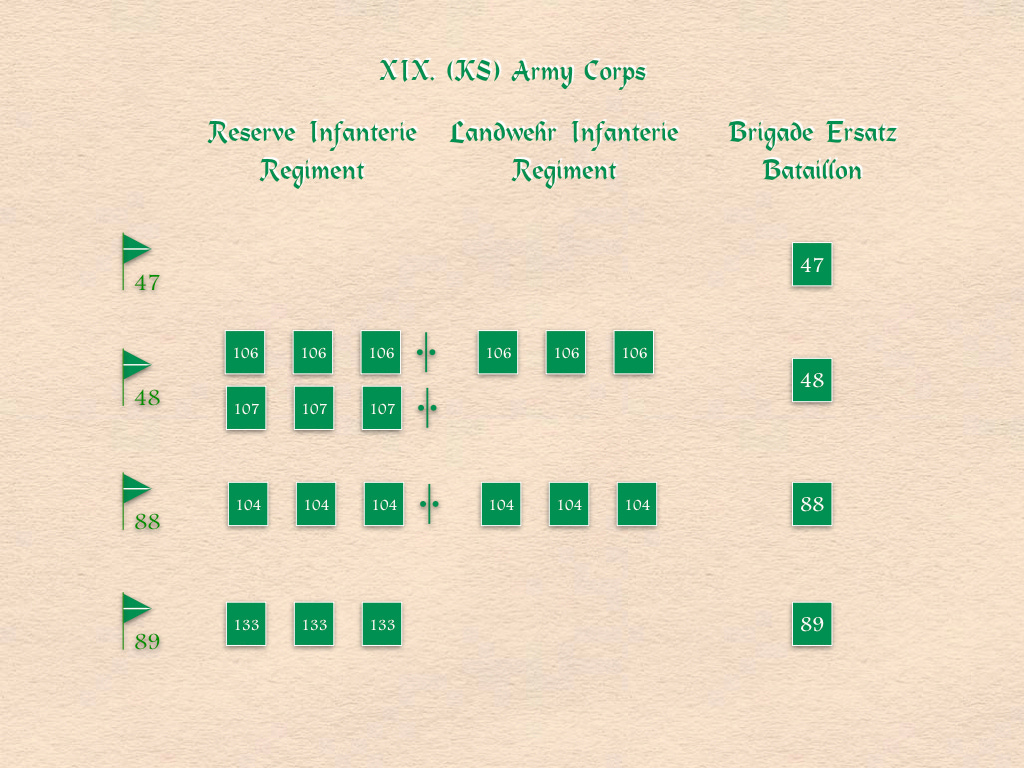The Saxon Army
Second-Line Infantry Units (1914)
The story of the Royal Saxon Army is a tale of two army corps. The older of these was formed in 1867, when the Kingdom of Saxony entered into a military convention with the Kingdom of Prussia that, among many other things, turned the existing army of the former into the XII (Royal Saxon) Army Corps of the North German Confederation. The younger, the XIX (Royal Saxon) Army Corps, owed its existence the great expansion of the German armies of the late 1890s.
The same separation between old and new could be seen in sixteen of the seventeen peacetime infantry regiments of the Royal Saxon Army. Eight had been founded before 1709. Eight had been raised after 1881. (The remaining unit, the sui generis Royal Saxon Rifle Regiment, was the product of the merger, in the annus mirabilis of 1867, of three previously independent rifle battalions.)
Thanks to the aforementioned military convention, units of the XII (Royal Saxon) Army Corps received “second numbers” that put them in the same series as their counterparts from several other German states. (Eventually, units from all German states save Bavaria would be numbered in these series.) Thus, the 3rd Royal Saxon Infantry Regiment became the 3. Königlich Sächsiches Infanterie Regiment Nr. 102.
When, in the years between 1867 and 1914, the Kingdom of Saxony raised additional regiments, these were given whatever secondary numbers happened to be available at the moment of creation. Thus, while only eight of regiments had been formed after the signing of the military convention with Prussia, their numbers ranged from 133 to 182.
It is easy to imagine a Royal Saxon Army in which all of the young infantry regiments were assigned to the young XIX Army Corps while their older counterparts remained with the older XII Army Corps. The Saxon authorities, however, declined to erect an “age barrier” of that sort. Instead, they distributed regiments in a way that ensured that neither army corps possessed more than five regiments from each chronological category.
Only two of the eight infantry brigades of the peacetime army of the Kingdom of Saxony displayed any sort of “chronological diversity.” Indeed, six of them were composed of pairs of regiments that shared the same official date of creation [Stiftungstag]. (Marvelous to say, Infantry Regiments 139 and 179 shared the same birthday.)
When it came to the raising of second-line regiments, all six of the Landwehr infantry regiments, as well as seven of the eight Reserve infantry regiments, took their numbers from regiments formed before 1708. The sole exception to this rule was provided by the Royal Saxon 9th Infantry Regiment Nr. 133. (Formed on 1 April 1881, this was one of the oldest of the regiments formed after the founding of the German Empire.)
Sources: This post is based on data gleaned from the organizational appendix to the first volume of the German official history; Hermann Cron (C.F. Colton, translator) Imperial German Army: Organization, Structure, Orders-of-Battle (Solihull: Helion, 2002); Löbell's Jahresberichte über das Heer-und Kriegswesen [Löbell’s Military Matters and Warfare Annual], 1913, pages 12 and 13; and, where regimental birthdays are concerned, Eike Mohr, Heeres- und Truppengeschichte des Deutschen Reiches und seiner Länder 1806 bis 1918 (Osnabrück: Biblioverlag, 1989) pages 774-775.
Note: Sharp-eyed readers will notice that one of the regiments depicted on the first hat-and-helmet infographic is missing from the images that follow. This regiment, the Königlich Sächsiches 6. Infanterie Regiment Nr. 105, was assigned to a brigade in Strasburg. (As a unit stationed on the French frontier, this regiment did not form a brigade Ersatz battalion.)








Good stuff.
One small issue, according to my research into the original documents (my eyes still hurt from the font) Nr. 105 Regiment was assigned to 30. Division, which was stationed in Strasbourg.
(30. Division was not assigned to the Strasbourg Fortress, that was 30. Bavarian Reserve Division)